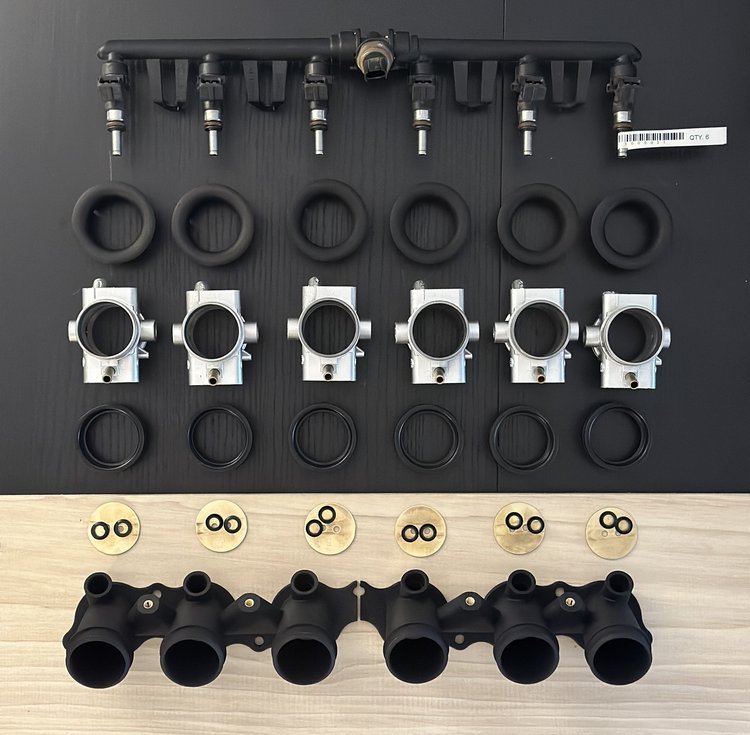Edition #TEN
Some Assembly Required
(This newsletter was previously sent out to our email subscribers. To receive updates the moment they happen, consider subscribing via our home page.)
September kicked off with a bang for Shoreline Bespoke! More specifically, it kicked off with our jaws on the floor as Kyle and I viewed the completed Laguna Prototype chassis for the first time. Here was an incredibly complex steel structure that we were both extremely familiar with, but only as viewed through a computer screen. Sitting in the car, staring out through the windshield frame felt like a dream that had morphed into reality. While this stage of the build has taken much longer than we originally anticipated, moments like this make us forget about the previous setbacks. We still managed to stay busy regardless of the delays, building the vehicle’s sub-assemblies in a very glamorous workshop known as the living room of our apartment.
One thing we learned during the fabrication process: the prototype chassis is over-built. This means we can reduce the weight of the production version while still ensuring Laguna has one of the stiffest and strongest frames of any production vehicle. We also looked into using a carbon fiber tub, but realized the tub in question would significantly compromise ergonomics - an immediate deal-breaker. We designed Laguna to offer a perfect driving position and more interior room than any other car in this category, and that could only be accomplished with our bespoke chassis. Plus, the weight benefit of the carbon tub can be realized by optimizing our existing chassis.
Kyle and I have been visiting the fabrication shop regularly to prepare some of the components that will eventually make their way onto the chassis, like the 100+ tabs that mount the floor, interior panels, and vehicle systems. We also built the pedal box, the engine’s new air intake, and the “corners” which include everything between the wheels and the chassis itself. You know, useful stuff like brakes.
The first step in building the corners was to attach the wheel bearing to the upright (the large chunk of metal that connects everything). These bolts must be torqued to exactly the right amount; they withstand enormous forces from freeway potholes to extreme cornering on a racetrack. Next, the AP Racing brakes get mounted to the upright, and finally the center-lock hub for our motorsport-style wheels. We were extremely happy to find that everything went together flawlessly on the first try. Naturally, we had to mount the wheels to see how everything looked fully assembled. We found our jaws on the floor once again, and a celebratory beer in our hands shortly after.
The pedal box was next - a little nerve wracking since it required modifying a very expensive and brand new piece of metal from Tilton Engineering. Tilton makes world-class pedal systems for all levels of motorsport, and were the obvious choice for one of the most important tactile interactions a driver will have with their Laguna. We designed a race-grade pedal box that provides an immense level of adjustability for pedal feel while offering a spacious landing for your feet, including a billet aluminum footrest. The aluminum structure houses all of the hydraulics and hardware underneath the floor, and a skeletonized front panel means you can see it working while you drive. After it was built, we test fit the pedal box in the chassis to check fitment and pedal travel. It feels incredible to operate - I can’t wait for you to try it!
Lastly, we assembled one of the most complicated subsystems of the entire car: the 3D-printed air intake for Laguna’s BMW-sourced engine. The original intake was designed very conservatively and fed the engine through a single throttle body. To meet our power requirements, we needed a new intake system with much more airflow. The end result was a motorsport-style setup with six individual throttle bodies providing ~3.3x more air, but tuning six throttle bodies is a lot harder than tuning just one! We decided to try something never done before and mounted all six throttles to a common shaft. Further testing will reveal whether this method allows the engine to idle smoothly, but the initial assembly procedure gave us a vote of confidence based on how well it operates. Below you can see an “exploded view” of the new intake system with its 3D-printed manifolds and trumpets, and how it compares to the original BMW intake.
Next month we expect to reach a big milestone: delivery of the completed chassis assembly with the engine, gearbox, seats, and steering installed. Once we have that, Kyle and I can mount all of the above assemblies onto the car and work towards firing it up for the first time. In the meantime, you can visit our website to learn more about our vision for Shoreline Bespoke, reach out, and shop for apparel. By subscribing to this newsletter, you’ll be the first to know about vehicle updates, upcoming reveals, apparel releases and more… Stay tuned.
Sincerely,
Spencer Beckman
Founder & CEO, Shoreline Bespoke Vehicles










